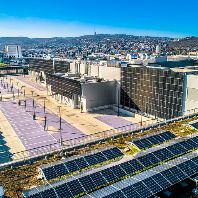Global institutional real estate capital flows of more than US $200 billion (158.8 bln.). could be invested in mature worldwide markets over the next five years, IPD delegates were told.
Speaking at IPD's Multinational Investment Seminar on Wednesday in central London, Invesco Real Estate's Director of European research Simon Mallinson said: "We have estimated a conservative figure of US $200 bln. in unleveraged capital could be invested in global markets over next five years by institutions. "This is the starting point for us to work out the impact of such a scale of fresh capital hitting the market chasing product, which will create varying supply and demand issues across world markets."
While sovereign wealth funds have the greatest appetite over the short-term and feature in the estimate, Mallinson said, the fact that SWFs are starting from a low base of real estate exposure, are still developing strategies and are looking to make large capital placements might mean their investment timeframe is extended awaiting market opportunities. "They may also be attracted to infrastructure rather than traditional real estate," he added.
Mallinson also raised the concern that, globally, defined benefit plans are being superseded by defined contribution (DC) plans which might limit the flow of capital as the direct real estate industry currently lacks the type of fund structures that can invest DC capital and provide the required liquidity.
Invesco Real Estate who along with JP Morgan have confirmed their sponsorship of the IPD Global Property Annual Index has devised its global institutional capital flows estimates based on analysis of current institutional real estate holdings together with target allocations across North America, Europe and Asia.
"Assuming we get this capital, where is it going to be spent?" concluded Mallinson. The thread was picked up by CBRE Director Michael Haddock who delivered a presentation on strategy in an unpredictable environment, the applicability of leverage and which he saw as attractive investment markets.
Haddock argued investment should be considered on a scoring matrix comprising demand, supply, pricing and market risk. "A rationale response to uncertainty in choosing investment destinations is to look at those markets that score well on factors you are confident about and that the things you are unconfident about don't matter."
He added that risk and uncertainty also has an impact on the use of leverage. Debt is used for three main reasons: to buy more assets, reduce specific risk (such as currency hedging for cross border investment) as well as an informal form of tax management (where interest paid against debt can be set off against tax liabilities). Haddock continued: "In an uncertain world, the argument for leverage breaks down because the impact of debt is exponential. The greater the level of uncertainty about the future, the lower the level of leverage should be applied."
He pointed to four markets which each had attractive property fundamentals over the short-term: Australia and Canada, both resource-based economies with tight supply, Poland and France. "Poland was one of few euro countries to avoid recession, very good supply side metrics, with tight development over next few years, while in France the supply side for Paris offices also particularly tight."
Conference chairman, Nassos Manginas, European Business Development Director at IPD, said: "Multinational clients' need to be measured and benchmarked against a peer group has become stronger than ever. As a result, there is an increased pressure for IPD to meet more frequent reporting requirements from annual to bi-annual and quarterly reporting and benchmarking. These are challenges that we share with our existing and potential new clients."
Elisabeth Troni, Global Real Estate Economist at UBS, provided the economic backdrop reminding delegates of the severity of recent macro dangers. She said: "What got us through the crisis point into this recovery period was expansionary fiscal policy















